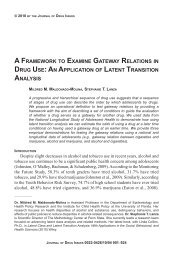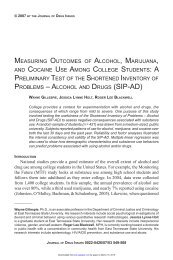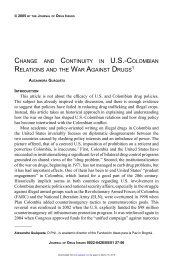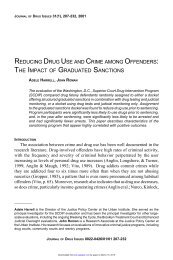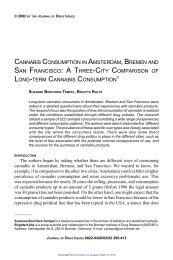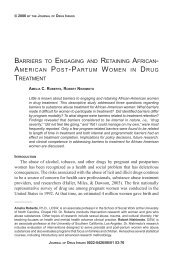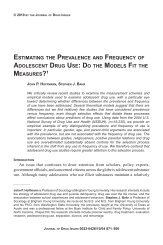a brief history of cannabis policies in spain - Journal of Drug Issues
a brief history of cannabis policies in spain - Journal of Drug Issues
a brief history of cannabis policies in spain - Journal of Drug Issues
Create successful ePaper yourself
Turn your PDF publications into a flip-book with our unique Google optimized e-Paper software.
GAMELLA, JIMÉNEZ RODRIGO<br />
<strong>of</strong> drug control where contradictions rema<strong>in</strong> po<strong>in</strong>t<strong>in</strong>g to conflicts among powers <strong>of</strong><br />
the state, regional and national governments, and different sectors <strong>of</strong> civil society<br />
that support disparate views <strong>of</strong> illegal drug use and its consequences. Today, <strong>cannabis</strong><br />
<strong>policies</strong> embody many <strong>of</strong> these conflicts dur<strong>in</strong>g a critical time when the use <strong>of</strong> this<br />
drug is reach<strong>in</strong>g record levels, and the world supply for <strong>cannabis</strong> has established<br />
some <strong>of</strong> its central entrepots <strong>in</strong> Spa<strong>in</strong> (see European Monitor<strong>in</strong>g Centre for <strong>Drug</strong>s<br />
and <strong>Drug</strong> Addiction [EMCDDA], 2003).<br />
Now, as is also true <strong>in</strong> other Western countries, measures concern<strong>in</strong>g hashish<br />
and marijuana are the most “active policy battlefront” <strong>in</strong> the drug policy debate<br />
(MacCoun & Reuter, 2001, p. 6). Although for more than a century there was a<br />
traditional consumption <strong>of</strong> marijuana related to the Spanish colonies <strong>in</strong> Northern<br />
Africa, the recent expansion <strong>of</strong> <strong>cannabis</strong> is an <strong>of</strong>fshoot <strong>of</strong> the “drug revolution” <strong>of</strong><br />
the late 1960s. S<strong>in</strong>ce the mid 1970s, <strong>cannabis</strong> derivatives have become the illicit<br />
drugs most <strong>of</strong>ten traded and consumed <strong>in</strong> Spa<strong>in</strong>. After a decrease <strong>in</strong> the late 1980s,<br />
the consumption <strong>of</strong> <strong>cannabis</strong> <strong>in</strong> the last decade has grown cont<strong>in</strong>uously among<br />
teenagers and young adults (Observatorio Español sobre Drogas [OED], 2002b,<br />
2003). By 2001, over 1.7 million people were us<strong>in</strong>g <strong>cannabis</strong> regularly, a portion<br />
<strong>of</strong> them daily (OED, 2003). In the new adolescent cohorts, those who have tried<br />
<strong>cannabis</strong> are becom<strong>in</strong>g a majority (OED, 2002a). Therefore, three generations <strong>of</strong><br />
Spaniards have smoked <strong>cannabis</strong>, and this drug is the center <strong>of</strong> a huge illegal market<br />
and a mean<strong>in</strong>gful modern tradition (Gamella & Jiménez Rodrigo, 2003).<br />
Moreover, <strong>cannabis</strong> is currently the cause <strong>of</strong> a social divide and a symbolic and<br />
political confrontation (Elzo et al., 1999; Megías, Comas, Elzo, Navarro, & Romaní,<br />
2000). Supporters <strong>of</strong> the present prohibitionist regime (and <strong>of</strong> an even more punitive<br />
one) see marijuana and its res<strong>in</strong> as dangerous drugs, harmful to physical and mental<br />
health, and the necessary gateway for the use <strong>of</strong> “harder” drugs such as coca<strong>in</strong>e,<br />
amphetam<strong>in</strong>es, or hero<strong>in</strong>. Prohibitionists oppose any leniency <strong>in</strong> respect to <strong>cannabis</strong><br />
dealers or those <strong>in</strong>dulg<strong>in</strong>g <strong>in</strong> home cultivation, seed sales, and even consumption.<br />
Among its defenders, marijuana is seen as safer, purer, and more natural than<br />
alcohol or tobacco: a nonaddictive, benign, and even therapeutic “green” drug.<br />
The notion that its use somehow leads to the abuse <strong>of</strong> more dangerous drugs is<br />
derided or judged as exaggerated by the majority <strong>of</strong> experienced <strong>cannabis</strong> users<br />
(Gamella & Jiménez Rodrigo, 2003; Mendiola & Becoña, 2003). In particular,<br />
<strong>cannabis</strong> has a positive image among teenagers who grew up dur<strong>in</strong>g the expansion<br />
<strong>of</strong> “drug education” and prevention programs <strong>of</strong> the late 1980s and 1990s (see<br />
OED, 2003).<br />
Besides, as we will see, the tighten<strong>in</strong>g <strong>of</strong> regulations s<strong>in</strong>ce 1992 has given a<br />
rebellious mean<strong>in</strong>g to <strong>cannabis</strong> use dur<strong>in</strong>g this period <strong>of</strong> maximum use and social<br />
acceptance (see OED, 2000, 2003). This apparent <strong>in</strong>consistency has worked well<br />
624 JOURNAL OF DRUG ISSUES<br />
Downloaded from jod.sagepub.com by guest on March 15, 2015








